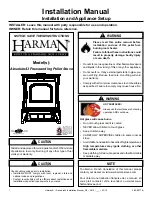
High-fire:
The flame should be bright yellow with a full fire-box height to where the flame
will begin to break up and terminate 2”-3” below the baffle at stove top. The base of the flame
at the burner ring should still be blue, going to white/yellow up to tip of flame, and the catalyst
will be a dull red. If the flame is too high and allowed to impinge on the baffle, the result will
be a cooling of the flame tip, and incomplete combustion, thereby producing smoke and soot.
Adjust the high-fire adjustment screw to achieve proper flame size.
*EACH ADJUSTMENT OF NO MORE THAN ONE-QUARTER TURN
SHOULD BE ALLOWED TO STABILIZE FOR FIVE MINUTES BEFORE MAKING
ANY FURTHER ADJUSTMENTS ON EITHER HIGH– OR LOW-FIRE.
*MAKE SURE THE FLUE PRESSURE IS CORRECT BEFORE MAKING ANY
CARBURETOR ADJUSTMENTS.
The carburetor on your Shasta has a main float valve internally to regulate the oil level
in the stove. It also has a separate, second safety float that can trip off if the oil level becomes
too high in the carburetor. Should this occur, you can reset the safety lever by clicking it back
down to start. You may need to reset the lever several times before the level of oil in the
carburetor returns to a normal level. Your Shasta has been rigorously tested to both U.L. 896
and U.L. 307A for both residential and mobile homes, and should the fire snuff out for any
reason, the carburetor will not allow more than 3/4” of oil in the bottom of the burner.
If you are experiencing excessive yellow, sooty flame on either high or low, you could be
building up excessive, fuel-rich gases inside your stove.
These gases can be explosive
. If this
condition exists, shut down the stove and contact your dealer about proper adjustment of the
carburetor and/or draft problems.
Should the fire go out for any reason,
NEVER ATTEMPT TO LIGHT A HOT
STOVE!
Try to determine why the stove went out and then allow the stove time to cool for 30
minutes before re-starting following the lighting instructions in this manual.
DRAFT STABILIZER ADJUSTMENTS:
After removing the rear draft stabilizer access cover at stove back, you will see that the
draft stabilizer has a weighted adjustment screw that you will be able to adjust to weigh more or
less on the stabilizer shutter to allow more or less air into the flue. With a suitable manometer,
probe into the flue, adjust the weighted screw to where the pressure reading falls within the
satisfactory operating range shown on the chart on the following page. If the flame or draft is
too high (not enough air entering the draft stabilizer) the fire can flicker excessively and make a
roaring noise. If too much air is entering the draft stabilizer, the flame will be weak and
smoky, producing soot on the glass. I
The flame will be taller and more yellow/orange in color.
This indicates a low negative pressure and inefficient draft. I
f a manometer is not available, set
the stabilizer while on high burn to the point where the stabilizer shutter is just closed with little
movement needed to push it open or closed.
When your Shasta is burning on low burn, the draft
stabilizer should be closed, but should wind or any other condition attempt to increase the draft, the
draft stabilizer should be able to flutter open, thereby adding air to the flue, slowing the draft to a
normal draft pressure.
Setting pressure with a manometer is highly recommended. Should the
flue be subjected to prolonged high winds or the flue itself is of high efficiency, the draft
stabilizer may not be able to supply enough air for an efficient burn. If this condition exists, a
second draft regulator in the pipe may be fitted to overcome the excessive draft, or a vacuum
cap may be necessary.
Please see chart on following page.
6






























